新目标英语_2012年新版_七年级下_教案_unit2_What_time_do_you_go_to_school
- 格式:doc
- 大小:152.00 KB
- 文档页数:13
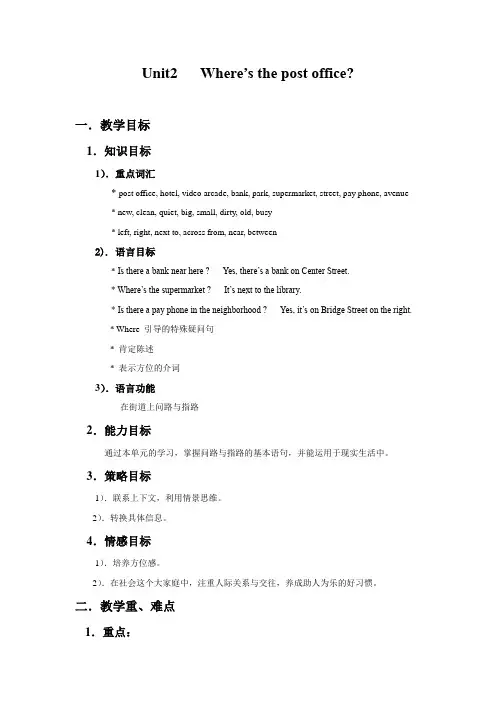
Unit2 Where’s the post office?一.教学目标1.知识目标1).重点词汇* post office, hotel, video arcade, bank, park, supermarket, street, pay phone, avenue* new, clean, quiet, big, small, dirty, old, busy* left, right, next to, across from, near, between2). 语言目标* Is there a bank near here ? Yes, there’s a bank on Center Street.* Where’s the supermarket ? It’s next to the library.* Is there a pay phone in the neighborhood ? Yes, it’s on Bridge Street on the right.* Where 引导的特殊疑问句* 肯定陈述* 表示方位的介词3).语言功能在街道上问路与指路2.能力目标通过本单元的学习,掌握问路与指路的基本语句,并能运用于现实生活中。
3.策略目标1).联系上下文,利用情景思维。
2).转换具体信息。
4.情感目标1).培养方位感。
2).在社会这个大家庭中,注重人际关系与交往,养成助人为乐的好习惯。
二.教学重、难点1.重点:1).表方位的介词:near、across from、next to、between、on2).问路与指路的基本语句2.难点:1).本单元词汇量较大(生词表中列出44个单词,9条短语;课文中还有一些短语)。
2).个别句子有一定难度,如:* Is there a big supermarket near where you live ?* Turn left off the busy First Avenue and enjoy the city’s quiet streets and smallparks.* ┉ there is a small house with an interesting garden.* Bridge Street is a good place to have fun.三.难点注释:* Is there a big supermarket near where you live ?在你住处附近有一家大超市吗?* Turn left off the busy First Avenue and enjoy the city’s quiet streets and smallparks.向左转走出/驶离繁华的第一大道,即可享受到城区里安静的街道和小公园。
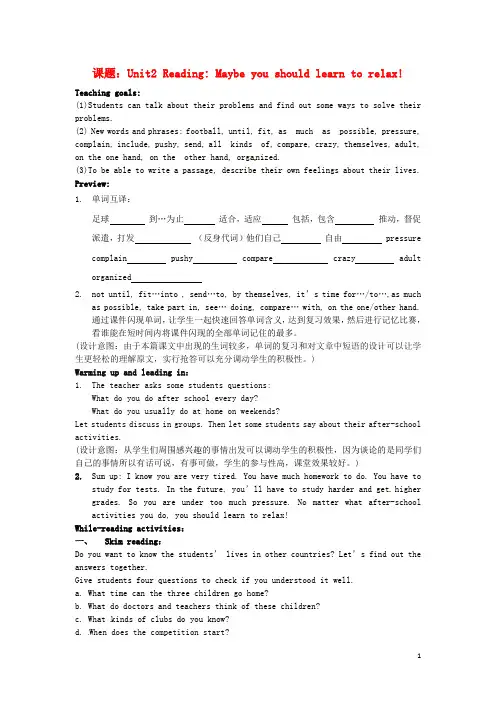
课题:Unit2 Reading: Maybe you should learn to relax!Teaching goals:(1)Students can talk about their problems and find out some ways to solve their problems.(2) New words and phrases: football, until, fit, as much as possible, pressure, complain, include, pushy, send, all kinds of, compare, crazy, themselves, adult,on the one hand, on the other hand, orga nized.(3)To be able to write a passage, describe their own feelings about their lives. Preview:1.单词互译:足球到…为止适合,适应包括,包含推动,督促派遣,打发(反身代词)他们自己自由 pressure complain pushy compare crazy adult organized2.not until, fit…into , send…to, by themselves, it’s time for…/to…,as m uchas possible, take part in, see… doing, compare… with, on the one/other hand.通过课件闪现单词,让学生一起快速回答单词含义,达到复习效果,然后进行记忆比赛,看谁能在短时间内将课件闪现的全部单词记住的最多。
(设计意图:由于本篇课文中出现的生词较多,单词的复习和对文章中短语的设计可以让学生更轻松的理解原文,实行抢答可以充分调动学生的积极性。

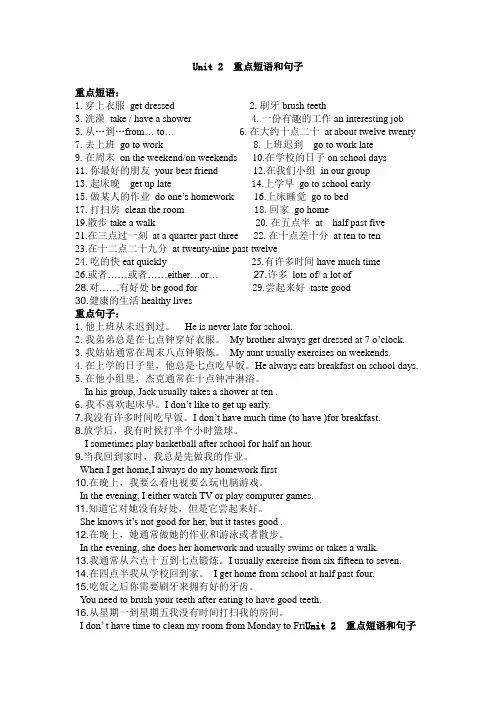
Unit 2 重点短语和句子重点短语:1.穿上衣服get dressed2.刷牙brush teeth3.洗澡take / have a shower4.一份有趣的工作an interesting job5.从…到…from… to…6.在大约十点二十at about twelve twenty7.去上班go to work8.上班迟到go to work late9.在周末on the weekend/on weekends 10.在学校的日子on school days11.你最好的朋友your best friend 12.在我们小组in our group13.起床晚get up late 14.上学早go to school early15.做某人的作业do one’s homework 16.上床睡觉go to bed17.打扫房clean the room 18.回家go home19.散步take a walk 20.在五点半at half past five21.在三点过一刻at a quarter past three 22.在十点差十分at ten to ten23.在十二点二十九分at twenty-nine past twelve24.吃的快eat quickly 25.有许多时间have much time26.或者……或者……either…or…27.许多lots of/ a lot of28.对……有好处be good for 29.尝起来好taste good30.健康的生活healthy lives重点句子:1.他上班从未迟到过。
He is never late for school.2.我弟弟总是在七点钟穿好衣服。
My brother always get dressed at 7 o’clock.3.我姑姑通常在周末八点钟锻炼。
My aunt usually exercises on weekends.4.在上学的日子里,他总是七点吃早饭。
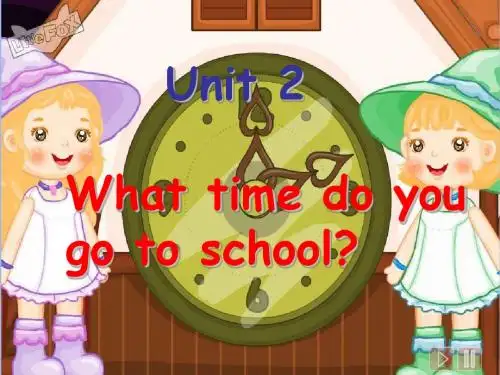

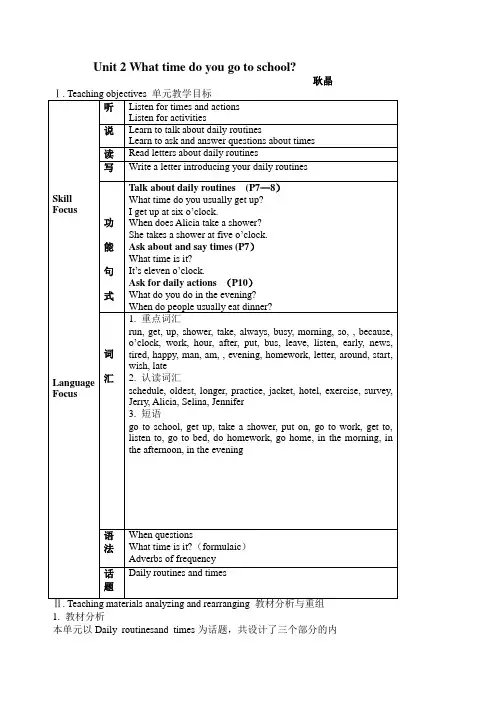
Unit 2 What time do you go to school?耿晶1. 教材分析本单元以Daily routinesand times为话题,共设计了三个部分的内容。
旨在通过单元教学使学生学会谈论日常行为、询问并答复有关时间的问题、询问并回答人们在特定时间所从事的活动。
Section A 学习谈论日常作息时间。
1a, 1b, 1c 重点学习和学生息息相关的几种日常行为的英文表示方法,学会询问和答复日常作息时间。
2a, 2b, 2c ,2d继续学习谈论自己或他人的日常作息时间。
重点学习如何询问,这也是本单元的语法重点。
3a, 3b, 3c 学会叙述他人的日常活动安排,同时学习询问时间和时间表达法,进一步巩固询问别人的日常作息时间的表达法。
Section B 继续学习询问和谈论别人的日常行为。
1a, 1b, 2a, 1c,1d,1e,学会谈论和询问一天内各个时间段的活动安排。
2a,2b,3a,3b学会通过两个人的对比介绍来判断并养成好的作息时间。
Self check 重点单词句型复习2. 课型设计与课时分配Period 1 Listening and speaking (I)(Section A: 1a, 1b, 1c)Period 2 Listening and speaking (II)(Section A:2a, 2b, 2c,2d)Period 3 Integrating skills(Section A:3a, 3b, 3cSection B: 1a, 1b,1c,1d,1e)Period 4 Reading and writing(Section B:2a, 2b, 2c,3a,3b)Period 5 Self checkⅢ. Teaching plans for each periodPeriod 1 Listening and speaking(Ⅰ) Target language目标语言1. Words && phrases生词和短语Up,get up,dress,get dressed,brush,tooth,shower,take a shower,usually,forty, what time,2. Key sentences重点句子When do people usually ...? People usually ...What time do you usually ...? I usually ...Ability goals能力目标Enable students to learn to talk about daily routines.Learning ability goals学能目标Help the students learn how to talk about daily routines.Teaching important / difficult points教学重难点How to talk about daily routines.Teaching aids教具准备A tape recorder and a model clock.Teaching procedures and ways教学过程与方式Step ⅠWarming upIn this procedure, motivate students to learn some words and phrases by singing the songs they’ve learned before.T: Good morning, everyone. (sing) “Good morning to you. Good morning to you. Good morning, dear children. Good morning to you.” This song is easy to learn. Who can sing it to us?Encourage students to sing the song.T: Well done. Thank you! We sing “Good morning to you” in the morning. Then what do we sing in the afternoon and in the evening? S: We sing Good afternoon to you in the afternoon and Good evening to you in the evening.T: That’s right. I know all of you are very good at singing. Does anyone want to sing Good afternoon to you or Good evening to you to us?Step ⅡTalking and reading (1a)In this procedure, ask students to finish the required task and learn some key phrases about daily actions.T: As we all know, time is very important and in English there is a famous saying "An hour in the morning is worth two in the evening." So what do you do in the morning?S1: I read English. S2: I do morning exercise.T: And what do you do in the afternoon and in the evening?S1: I play basketball in the afternoon. S2: I watch TV in the evening.T: I’m very glad to hear that. You use your time very well. And there’re many daily things we can do. Now let’s read these phrases in 1a and match these actions and the time of day.Step ⅢPracticeIn this procedure, students will learn how to talk about actions and the time of day.T: I know you’re very clever. Now I want you to tell if my statements are right or wrong. First, I usually eat dinner in the morning. S: Wrong.T: When do I usually eat dinner? S: In the evening.T: Second, she gets up at 19:00 in the morning. S: Wrong.T: What is the correct way of saying the sentence? S: She gets up at 7:00 in the morning.T: How clever you are! Now let’s read the conversation in groups and see which group reads better.Ask students to do pairwork.T: Please ask your partner when people usually do these things: do homework, eat dinner, eat breakfast and go to bed.(Write “When do people usually ...”on the blackboard)Sample dialogue:S1: When do people usually do homework?S2: People usually do homework in the afternoon.Interest the students in going on practicing the conversation using a new way of reading.T: Now let’s try a new way of reading. First I name one student to ask a question, and then ask all of you repeat this question together. After that, I name another student to answer this question, and all of you repeat the answer together.Sample dialogue:S1: When do people usually go to bed?S: When do people usually go to bed?S2: People usually go to bed in the evening.S: People usually go to bed in the evening.Step ⅣTalking about time (1c)In this procedure, students will learn how to ask about and say hour times and learn some key phrases about daily routines.T: Boys and girls, please listen to what I’m saying and guess what it is. 小小骏马不停蹄,日日夜夜不休息,蹄声哒哒似战鼓,提醒人们争朝夕。
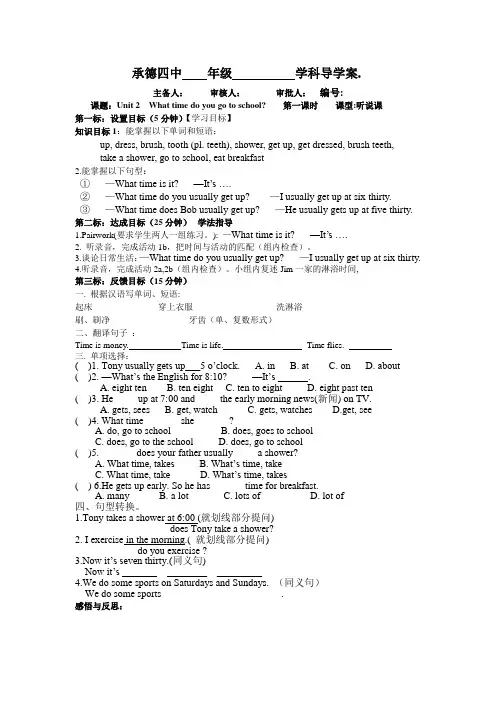
承德四中年级学科导学案.主备人:审核人:审批人:编号:课题:Unit 2 What time do you go to school? 第一课时课型:听说课第一标:设置目标(5分钟)【学习目标】知识目标1:能掌握以下单词和短语:up, dress, brush, tooth (pl. teeth), shower, get up, get dressed, brush teeth,take a shower, go to school, eat breakfast2.能掌握以下句型:①—What time is it? —It’s ….②—What time do you usually get up? —I usually get up at six thirty.③—What time does Bob usually get up? —He usually gets up at five thirty. 第二标:达成目标(25分钟)学法指导1.Pairwork(要求学生两人一组练习。
): —What time is it? —It’s ….2. 听录音,完成活动1b,把时间与活动的匹配(组内检查)。
3.谈论日常生活:—What time do you usually get up? —I usually get up at six thirty.4.听录音,完成活动2a,2b(组内检查)。
小组内复述Jim一家的淋浴时间,第三标:反馈目标(15分钟)一. 根据汉语写单词、短语:起床_______________穿上衣服___________________洗淋浴_________________刷、刷净__________________牙齿(单、复数形式)________ __________二、翻译句子:Time is money. Time is life. Time flies. ______三. 单项选择:( )1. Tony usually gets up___5 o’clock. A. in B. at C. on D. about ( )2. —W hat’s the English for 8:10? —It’s ______.A. eight tenB. ten eightC. ten to eightD. eight past ten( )3. He_____up at 7:00 and_____the early morning news(新闻) on TV.A. gets, seesB. get, watchC. gets, watchesD.get, see( )4. What time _______she_______?A. do, go to schoolB. does, goes to schoolC. does, go to the schoolD. does, go to school( )5. _______does your father usually ____ a shower?A. What time, takesB. What’s time, takeC. What time, ta keD. What’s time, takes( ) 6.He gets up early. So he has ______ time for breakfast.A. manyB. a lotC. lots ofD. lot of四、句型转换。
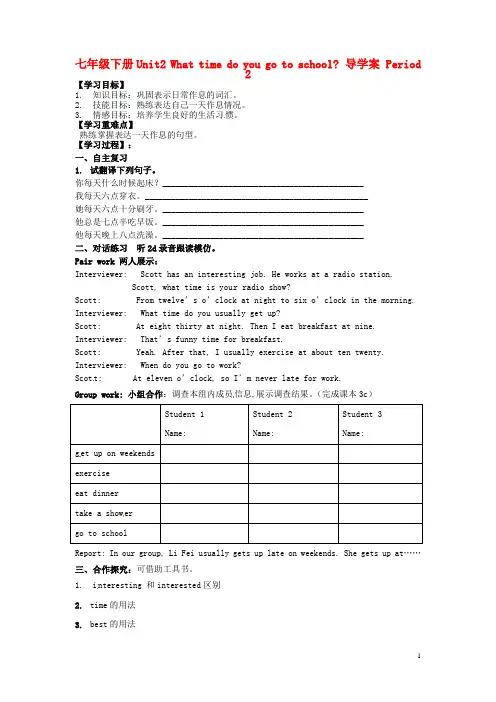
七年级下册Unit2 What time do you go to school? 导学案 Period2【学习目标】1.知识目标:巩固表示日常作息的词汇。
2.技能目标:熟练表达自己一天作息情况。
3.情感目标:培养学生良好的生活习惯。
【学习重难点】熟练掌握表达一天作息的句型。
【学习过程】:一、自主复习1.试翻译下列句子。
你每天什么时候起床?______________________________________________我每天六点穿衣。
___________________________________________________她每天六点十分刷牙。
______________________________________________他总是七点半吃早饭。
______________________________________________他每天晚上八点洗澡。
______________________________________________二、对话练习听2d录音跟读模仿。
Pair work 两人展示:Interviewer: Scott has an interesting job. He works at a radio station.Scott, what time is you r radio show?Scott: From twelve’s o’clock at night to six o’clock in the morning. Interviewer: What time do you usually get up?Scott: At eight thirty at night. Then I eat breakfast at nine. Interviewer: That’s funny time for breakfast.Scott: Yeah. After that, I usually exercise at about ten twenty. Interviewer: When do you go to work?Scot t: At eleven o’clock, so I’m never late for work.Group work: 小组合作:调查本组内成员信息,展示调查结果。
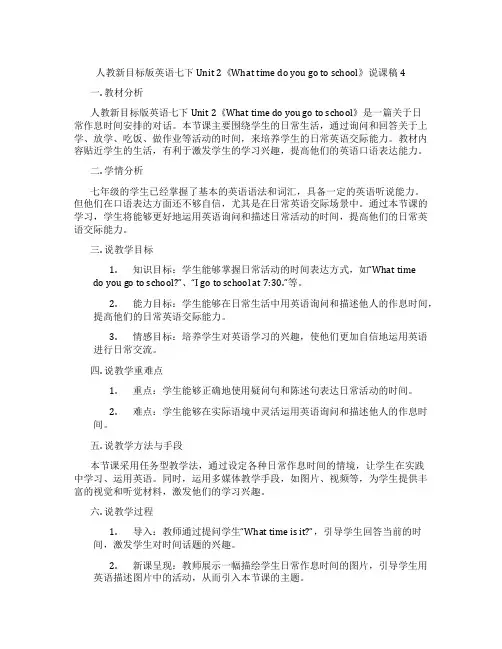
人教新目标版英语七下Unit 2《What time do you go to school》说课稿4一. 教材分析人教新目标版英语七下Unit 2《What time do you go to school》是一篇关于日常作息时间安排的对话。
本节课主要围绕学生的日常生活,通过询问和回答关于上学、放学、吃饭、做作业等活动的时间,来培养学生的日常英语交际能力。
教材内容贴近学生的生活,有利于激发学生的学习兴趣,提高他们的英语口语表达能力。
二. 学情分析七年级的学生已经掌握了基本的英语语法和词汇,具备一定的英语听说能力。
但他们在口语表达方面还不够自信,尤其是在日常英语交际场景中。
通过本节课的学习,学生将能够更好地运用英语询问和描述日常活动的时间,提高他们的日常英语交际能力。
三. 说教学目标1.知识目标:学生能够掌握日常活动的时间表达方式,如“What timedo you go to school?”、“I go to school at 7:30.”等。
2.能力目标:学生能够在日常生活中用英语询问和描述他人的作息时间,提高他们的日常英语交际能力。
3.情感目标:培养学生对英语学习的兴趣,使他们更加自信地运用英语进行日常交流。
四. 说教学重难点1.重点:学生能够正确地使用疑问句和陈述句表达日常活动的时间。
2.难点:学生能够在实际语境中灵活运用英语询问和描述他人的作息时间。
五. 说教学方法与手段本节课采用任务型教学法,通过设定各种日常作息时间的情境,让学生在实践中学习、运用英语。
同时,运用多媒体教学手段,如图片、视频等,为学生提供丰富的视觉和听觉材料,激发他们的学习兴趣。
六. 说教学过程1.导入:教师通过提问学生“What time is it?”,引导学生回答当前的时间,激发学生对时间话题的兴趣。
2.新课呈现:教师展示一幅描绘学生日常作息时间的图片,引导学生用英语描述图片中的活动,从而引入本节课的主题。
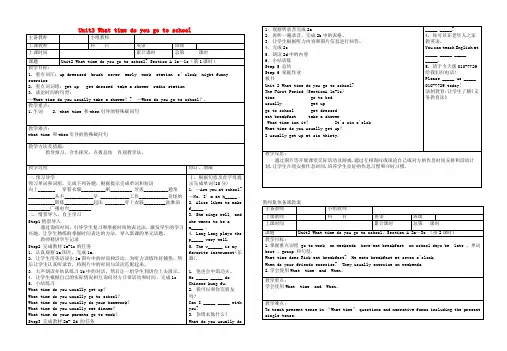
人教版新目标七年级英语下册Unit2Whattimedoyougotoschool语法篇试题学生通过本讲学习,能够掌握本单元的重点语法,并在综合能力上有一定的拓展。
一、what time与when1.what time翻译为“几点”问的是具体的时间,一般回答要具体到小时。
What time do you go to school?你什么时候/几点上学?I go to school at half past seven o’clock.我七点半去上学。
回答具体到点钟,且注意在几点前边的介词用at。
2.when也是对时间的提问,但与what time的区别是:用when提问,回答既可以是具体的时间,也可以是不具体的时间,如:in the morning,last year,in 1998等范围大的时间,例如:When does he take a shower?他什么时候洗澡?He takes a shower in the morning.他在早上洗澡。
也可用具体时间:I take a shower at 6 o’clock in the morning.我早上六点洗澡。
3. 问对方时间点只能用what time,如What time is it?二、频率副词的使用用法几个频率副词的用法★alwaysalways 意为“总是”,与进行时态连用时,可以表示赞扬,也可以表示讨厌等感情色彩。
e.g.(1)I shall always remember my first day at school. 我将永远记住我上学的第一天。
(2)He is always smoking. 他总是抽烟。
★usuallyusually可以指通常的动作,但是侧重已经形成的习惯,它是从已经形成的角度来说明动作。
e.g.(1)I usually do some shopping with my parents on Sundays. 我经常在星期天和我的父母一起去买东西。
Unit2第五课时Section B (2a-2c)Teaching and learning Goals:(一)语言知识及功能:1. 能正确拼读、识记并使用本课时的词汇:quickly, either ,either… or…, lot,lots of, sometimes, taste2. 能学会正确使用与日常活动相关的常用表达:get up, go to school, brush teeth, eat hamburgers/fruit/vegetables/ice-cream, play basketball/volleyball, watch TV, play computer games, do homework, go to bed, go home, swim, take a walk/shower,等。
3. 能运用快读略读和慢读细读等阅读技巧,理解文章大意,了解文章细节,能够分辨哪些日常活动属健康的范畴,哪些不健康。
(二)学习策略:自主学习、合作探究、Classifying 和Role-playing(三)情感目标:学会合理安排自己的学习和生活,逐渐养成良好的作息习惯,能在生活中关心自己和他人。
(四)文化知识:了解英语国家人们的日常生活习惯。
Teaching and learning steps:Step I. PreviewAsk Ss to read the book and put the Chinese into English orally, then write themdown without looking at your book.1.英汉互译(短语)①早起__________ ②吃蔬菜________ ③吃得快____________________④做运动_________ ⑤刷牙__________ ⑥吃顿丰盛的早餐____________⑦go to bed early___________⑧ eat ice-cream__________⑨take a shower___________ ⑩go to school_________2.翻译句子。
课题:Unit 2 What time do you go to school?第三课时 Section B (1a—1e)Learning Goals:In this period, the students will learn the ways to say times. They’ll know there are two ways to say each time, and the use of past and to is a difficulty for the students. At the same time, the students will learn some phrases and use them to make conversations and practice their listening skills. The students are supposed to pay attention to the verb forms in their sentences.Teaching and learning steps:Step 1 ReviewWrite some times on the blackboard and let the students read them (First read the hours, then read the minutes).eg, 11:00, 4:05, 7:10, 9:15, 5:30, 2:45, 10:55(上面列举的几个时间很有代表性,除了复习上节课学习的时间读法---先读小时,后读分钟,还为将要学习的第二种读法做了铺垫,后面的学习能充分运用这几个时间来练习。
)Let the students use the phrases learned in Section A to ask and answer in pairs like this:A: What time do you get up?B: I usually get up at six o’clock. When do you go to school?A: I always go to school at seven thirty.(这一复习环节既复习了上节课学习的重要短语,又复习了what time和when两个疑问词的运用,并指出他们的共同点和差别。
新目标版英语七年级下册Unit 2 What time do you go to school?(Section A)一、根据句意及首字母提示完成句子1、根据句意及首字母提示完成句子(1)Tom is very young. He can't get d________ by himself(他自己).(2)Jim is seven years old. He can b________ his teeth in the morning.(3)—What's ten and thirty?—It's f________.(4)I always get up e________. I never get up late.(5)There are many(许多的)buses(公共汽车)at the bus s________.二、用所给词的适当形式填空2、用所给词的适当形式填空(1)—What time do you usually________ (eat) breakfast?—At seven thirty.(2)“That's a ________ (fun) time for breakfast.(3)________ (Lily) family has a cat. It's very interesting.(4)Jim usually ________ (do) his homework after school.(5)He ________ (brush) his teeth after he gets up every morning.三、从方框中选择合适的单词并用其正确形式完成句子3、从方框中选择合适的单词并用其正确形式完成句子(1)What do you ________ do on Sundays?(2)I ________ walk to school when it's sunny.(3)My father gets up early every day, so he is ________ late for work.(4)The sun(太阳) ________ rises(升起) in the east(东方) and sets in the west.(5)Tina finds a good ________. She ________ very hard (努力地) every day.(6)Mary wants to be a singer. She thinks it's an interesting ________.四、单选题4、Li Ming is the best student in our class. He __________ gets good grades(成绩).A、alwaysB、sometimes(有时)C、neverD、often5、Cathy was born blind(天生是盲的), so she has __________ seen our beautiful world.A、oftenB、sometimesC、seldom(很少)D、never6、My father, Mr. White, often __________ at six twenty in the morning.A、get upB、go upC、gets upD、go to bed7、Kate takes a shower at 8 o'clock in the evening.(替换画线部分)A、playsB、lovesC、hasD、brings8、—Do you like this movie?—Yes, it's the __________ one I've ever seen(曾经看过的).A、betterB、bestC、goodD、well9、—When do you go to school?—We go to school __________ Monday __________ Friday.A、on; toB、from, toC、in; andD、in, to10、Could I have an early morning call __________ six o'clock tomorrow(明天) ?A、onB、toC、atD、in11、The child doesn't need any help. He is old enough to __________ himself.A、put onB、wearC、dressD、take care12、__________ your father __________ watching TV in the evening?A、Does, likesB、Does, likeC、Is; LikesD、Do, likes13、Susan __________ her homework at school every weekend.A、don'tB、don't doC、doesn'tD、doesn't do五、按要求改写句子14、按要求改写句子(1)He wants to know about my weekend.(改为一般疑问句并作否定回答)________ he ________ to know about your weekend?No, he ________.(2)She goes to school at seven thirty.(改为否定句)She ________ ________to school at seven thirty.(3)She often has dinner at half past six in the evening(对画线部分提问)________ ________ does she often have dinner in the evening?(4)I take a shower at 8:00 in the morning.(对画线部分提问)________ ________ you ________ a shower in the morning?(5)I usually learn English at eight on the radio.(用he代替I改写句子)He ________ ________ English at eight on the radio.六、根据汉语完成句子15、根据汉语完成句子(1)—你几点钟锻炼?—我通常五点五十锻炼。
Unit 2Ⅰ. 单项选择(10分)() 1. —What’s the time? —It’s _______ three-thirty. A. of B. around C. at() 2. I usually go to bed _______ ten o’clock. A. in B. after C. on() 3. Please write and tell me _______ your school lday. A. about B. for C. with() 4. We often do _______ homework at home. A. we B. us C. our() 5. _______ interesting movie it is! A. What B. How C. What an() 6. Please come _______ here. Don’t go _______ now. A. to; home B. /; to home C. /; home()7. I usually watch TV _______ Saturday evenings. A. on B. in C. at()8. Sorry, I can’t go with you. I have _______ homework to do. A. little B. many C. lots of()9. —_______ do you eat breakfast? —At seven-thirty. A. What B. What time C. Where()10. —Do you know ________? —Sorry, I don’t know.A. what is his nameB. what his name isC. what name is hisⅡ. 完形填空My brother works in a store. It’s near(在……附近) a 11 . The students come to 12 pens or food every day. My brother 13 at 6:00 in the morning. He 14 a bus to the store. He gets 15 the store at 6:50. His work 16 at 7:00. 17 things are on sale, 18 lots of students come to the store. My brother is very happy to meet 19 and the students 20 to see my brother very much.()11. A. hotel B. park C. school()12. A. sell B. see C. buy()13. A. eats lunch B. gets up C. goes to bed ()14. A. takes B. brings C. has()15. A. in B. to C. at ()16. A. starts B. goes C. comes ()17. A. A lot B. A little C. Many ()18. A. also B. but C. and ()19. A. it B. them C. him ()20. A. listen B. love C. writeⅢ. 阅读理解AMy name is Dennis. I’m a worker(工人) of a big store. I don’t work in the morning. I work at night. Every morning I come home at around 6:30. I have break-fast at 7:00. After breakfast I go to bed. I get up at around 2:30. I have lunch at 2:45 and dinner at 7:40. Then I go to work at 8:30. My work starts at 9:00. I look after(照看) the store every night. I like my work very much.阅读短文后,选择最佳答案。
沙桥中学教师集体备课教案第三周第 1 课时教学课题Unit 2 What time do you go to school?Period 1 (Section A 1a, 1b, 1c) 教学时间45 Minutes教学目标1.Enable students to learn to talk about daily routines.2.Help the students learn how to talk about daily routines.重点What time do you usually ...?I usually ...难点How to talk about daily routines. 教学准备Tape recorder; Multi-Media;PPT 附课件教学过程设计意图Step One .Lead-inIn this procedure, motivate students to learn some words and phrases by singing the songs they’ve learned before.T: Boys and girls, please listen to what I’m saying and guess what it is.It’s round. It has no legs and no arms. It can make “Di—Dar”.======(Clock)S: It’s a clock.T: Well done! Please look at this clock. (Hour hand pointing to 5) It’s five o’clock now. What time is it now? (Hour hand pointing to 1.)S: One o’clock.Go on practicing asking and answering questions about time.T: I usually get up at six in the morning and I know you get up early, too. What about the children in foreign countries? Let’s learn something about their times.Step Two. Match work (1a)In this procedure, ask students to finish the required task and learn some key phrases about daily actions.Step Three. Listening (1b)In this procedure, ask students to finish the listening task. Help them fill in the following table and then finish Activity 1b on Page 7.T: We’re going to listen to an interview about Rick’s morning. Please listen carefully and finish the table.Show the following.Actions Timesget upgo to schoolget dressedbrush teetheat breakfasttake a showerCheck the answers. Play the recording again and ask students to draw a line from the clock time to the correct picture.Step Four: Pairwork (1c)In this procedure, students will learn how to talk about actions and the time of day.T: I know you’re very clever. Now I want you to tell if my statements are right or wrong. First, I usually eat dinner in the morning.S: Wrong.T: When do I usually eat dinner?S: In the evening.T: Second, she gets up at 19:00 in the morning.S: Wrong.T: What is the correct way of saying the sentence?S: She gets up at 7:00 in the morning.T: How clever you are! Now let’s read the conversation in groups and see which group reads better.Ask students to do pairwork.T: Please ask your partner when people usually do these things: do homework, eat dinner, eat breakfast and go to bed.(Write “When do people usually ...”on the blackboard)Sample dialogue:S1: When do people usually do homework?S2: People usually do homework in the afternoon.Interest the students in going on practicing the conversation using a new way of reading. T: Now let’s try a new way of reading. First I name one student to ask a question, and then ask all of you repeat this question together. After that, I name another student to answer this question, and all of you repeat the answer together.Sample dialogue:S1: When do people usually go to bed?S: When do people usually go to bed?S2: People usually go to bed in the evening.S: People usually go to bed in the evening.Step Five.HomeworkAsk students to learn the words and phrases by heart.第三周第 2 课时教学课题Unit 2 What time do you go to school?Period 2 (Section A 2a-2d) 教学时间40 Minutes教学目标1.Enable students to learn to ask and answer questions about the shower times.2.Help students learn how to ask and answer questions about the shower times.重点How to ask and answer questions about the shower times. 难点How to ask and answer questions about the shower times. 教学准备Tape recorder; Multi-Media. PPT附课件教学过程设计意图Step One . Warming-upAsk a student to draw a picture of a boy taking a shower.T: Hello, boys and girls. Do you know what will he / she draw? Wait and see ... Wow! What a nice picture! What is the boy doing?S: He’s taking a shower.T: Yes. He takes a shower every day. Do you often take a shower?S: Yes.T: When do you usually do it?S: I usually take a shower in the morning.S: I usually take a shower in the afternoon.S: I usually take a shower in the evening.T: How many people are there in your family, Ma Li?S: Three.T: How many showers do you have?S: Only one.T: So, you have to make a shower schedule. Right?S: Yes.T: In Rick’s family there’re seven people and one shower too. How can they take the shower? Now let’s learn about their shower schedule.Step Two.Listening (2a, 2b, 2c)In this procedure, ask students to listen to the recording and finish Activities 2a and 2b. Then check the answers in the following way.T: You see, Rick’s family is a big one. There’re five children in the family. Do you know who they are?S: They are Rick, Bob, Mary, Jerry and Alicia.T: Very good! From the recording, we know that Bob takes a shower at 5:00. He isthe first to take a shower. Then what time do Mary, Jerry, Rick and Alicia take a shower? Please listen again and complete the table in 2b.Encourage students to get further information.T: We know there’re five children in Rick’s family, but we can only see four of them. Where is the fifth child?S: He / she must be in the bathroom.T: Then who’s in the bathroom?S: Bob.T: Why?S: Because he takes the shower first.Then divide students into two groups. Ask and answer questions about Rick’s family.T: Now I’ll divide you into two groups: Group A and Group B. I say a name, then Group A ask a question “What time does ... take a shower?”Group B answer this question.Sample dialogue:T: Mary.Group A: When does Mary take a shower?Group B: She takes a shower at 6:00.T: Jerry.Group A: When does Jerry take a shower?Group B: He takes a shower at 7:00.Step Four. Pair work Roleplay the conversation in 2dStep Five.Explain some language points.Step Six. Homework1.Ask students to finish the exercises in the Workbook.2. Ask each student to make a clock to get ready for the next class.第三周第 3 课时教学课题Unit 2 What time do you go to school?Period 3 (grammar focus-3c) 教学时间40 Minutes教学目标grammar focus-3c重点What time is it?It’s ...When do you usually ...? What time do you ...?难点How to talk about daily routines and ask about times.教学准备Tape recorder; Multi-Media. PPT 附课件教学过程设计意图Step One . Step1 Warming-upGreet the whole class as usual,and check the homework.Step Two. Grammar Focus1.Read the sentences together, then do some translation exercise.2. what time 与when 都可以用来询问时间,它们有哪些相同点和不同点呢?让我们通过例句一起来总结一下吧。